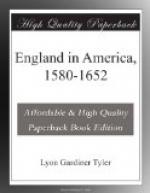Nevertheless, Baltimore played a losing game. At heart the Puritans in England were unfriendly to him because of his religion; and, when persistent rumors reached Maryland that Baltimore’s patent was doomed, some of the men of Providence appeared in England and urged that it be revoked.[34] At length, October 3, 1650, Parliament passed an ordinance authorizing the Council of State to reduce to obedience Barbadoes, Antigua, Bermudas, and “Virginia,” the last being a term which in England was often used to include Maryland. Baltimore struggled hard to have Maryland left out of the instructions drawn up afterwards by the Council of State; but though he was apparently successful, a descriptive phrase including his province was inserted, for the commissioners, Curtis, Claiborne, and Bennett, with an armed fleet, were instructed “to use their best endeavors to reduce all the plantations within the Bay of Chesopiack to their due obedience to the Parliament of England."[35]
After the commissioners had reduced Virginia, they found even less resistance in Maryland. The commissioners landed at St. Mary’s, and, professing their intention to respect the “just rights” of Lord Baltimore, demanded that Stone should change the form of the writs from the name of Lord Baltimore to that of Parliament. Stone at first declined to comply, and the commissioners, March 29, 1652, put the government into the hands of a council of leading Protestants. Stone then reconsidered his action, and Claiborne and Bennett, returning to St. Mary’s, restored him to the government, June 28, 1652, in conjunction with the councillors already appointed. The ascendency of Claiborne seemed complete, but beyond renewing his property claim to Kent and Palmer islands, he did not then further interfere.[36]
Maryland consisted at this time of four counties: St. Mary’s, erected in 1634, Kent, 1642, and Charles and Anne Arundelin 1650, and contained a population perhaps of eight thousand. The settlements reached on both sides of the bay, from the Potomac to the Susquehanna. Society was distinctly democratic, for while there were favored families there was no privileged class, and the existence of African slavery and the temporary servitude of convicts and redemptioners tended to place all freemen on an equality. As there was no state church, educational opportunities in the province were small, but it was a land of plenty and hospitality, and charity in religion made the execution of the criminal law singularly mild. In spite of turmoils and dissensions, Maryland prospered and flourished. A home feeling existed, and there were many even among the recent exiles from Virginia who looked with hope to its future and spoke of it as “a country in which I desire to spend the remnant of my days, in which I covet to make my grave."[37]
[Footnote 1: Md. Archives, III., 32.]
[Footnote 2: Md. Archives, V., 158.]
[Footnote 3: Hening, Statutes, I., 154. ]




